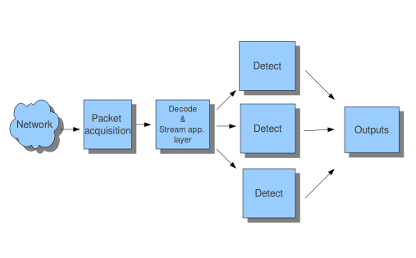This documentation is no longer maintained and exists for historical purposes. The current documentation is located at http://suricata.readthedocs.io/.
Runmodes¶
Suricata consists of several 'building blocks' called threads, thread-modules and queues.
A thread is like a process that runs on a computer. Suricata is multi-threaded, so multiple threads are active at once.
A thread-module is a part of a functionality. One module is for example for decoding a packet, another is the detect-module and another one the output-module.
A packet can be processed by more than one thread. The packet will be passed on to the next thread through a queue. Packets will be processed by one thread at a time, but there can be multiple packets being processed at a time by the engine. (see suricata.yaml)
A thread can have one or more thread-modules. If they have more modules, they can only be active on a a time.
The way threads, modules and queues are arranged together is called the Runmode.
Different runmodes¶
You can choose a runmode out of several predefined runmodes. The command line option --list-runmodes shows all available runmodes.
All runmodes have a name: auto, single, autofp.
The heaviest task is the detection; a packet will be checked against thousands of signatures.
Example of the default runmode:

In the pfring mode, every flow follows its own fixed route in the runmode.

For more information about the command line options concerning the runmode, see Command Line Options.
locked